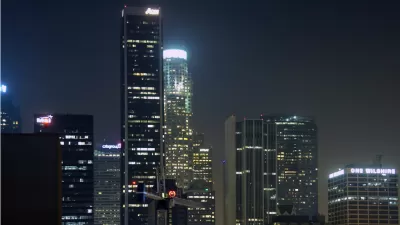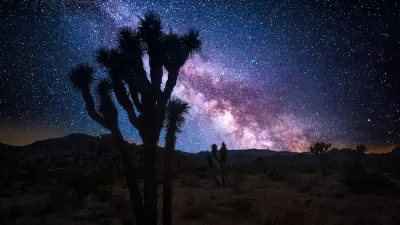There's a third dimension to sprawl: all those photons that emanate from street lights, houses, and vehicles. As author Paul Bogard discusses in The End of Night, light pollution is an overlooked menace that presents a new frontier for planners.
"The trillions of points of light in the true night sky are no match for the mere billions on the ground. You know the culprits: streetlights; parking lots; gas stations; billboards; preening McMansions; 'security' lighting; athletic fields; headlights....and on and on. Parking lots alone can account for up to 50% of a city’s outdoor lighting. It all piles up in icteritious 'domes' that hover above every urban area in the country."
"Just as Americans in the 1950s gleefully inhaled smog in the name of progress, Americans now surrender the night for much the same reason. Tablets and smart phones are today’s cigarettes, enabling us to further disrupt our eyesight, hormone production, and circadian rhythms."
"Ordinances regulating light pollution could be integrated into a general plan, replete with Bortle ratings to set goals and track progress. The International Dark-Sky Association, an admittedly quirky organization to which Bogard makes repeated reference, has model programs that can help cities reconnect their citizens to the sublime."
"There's an argument to be made that atmospheric light pollution should be covered under the California Environmental Quality Act. CEQA does refer to light pollution, but that typically refers to nuisances in an immediate area. The entire skyscape might be a tough one for public officials to regulate: it is either immutable or, at a few light years’ remove, too far out of their jurisdiction. But surely the health risks of artificial light to 39 million people might justify action?"
FULL STORY: The Dark Side of Environmental Quality

Alabama: Trump Terminates Settlements for Black Communities Harmed By Raw Sewage
Trump deemed the landmark civil rights agreement “illegal DEI and environmental justice policy.”

Planetizen Federal Action Tracker
A weekly monitor of how Trump’s orders and actions are impacting planners and planning in America.

Why Should We Subsidize Public Transportation?
Many public transit agencies face financial stress due to rising costs, declining fare revenue, and declining subsidies. Transit advocates must provide a strong business case for increasing public transit funding.

Understanding Road Diets
An explainer from Momentum highlights the advantages of reducing vehicle lanes in favor of more bike, transit, and pedestrian infrastructure.

New California Law Regulates Warehouse Pollution
A new law tightens building and emissions regulations for large distribution warehouses to mitigate air pollution and traffic in surrounding communities.

Phoenix Announces Opening Date for Light Rail Extension
The South Central extension will connect South Phoenix to downtown and other major hubs starting on June 7.
Urban Design for Planners 1: Software Tools
This six-course series explores essential urban design concepts using open source software and equips planners with the tools they need to participate fully in the urban design process.
Planning for Universal Design
Learn the tools for implementing Universal Design in planning regulations.
Caltrans
Smith Gee Studio
Institute for Housing and Urban Development Studies (IHS)
City of Grandview
Harvard GSD Executive Education
Toledo-Lucas County Plan Commissions
Salt Lake City
NYU Wagner Graduate School of Public Service





























